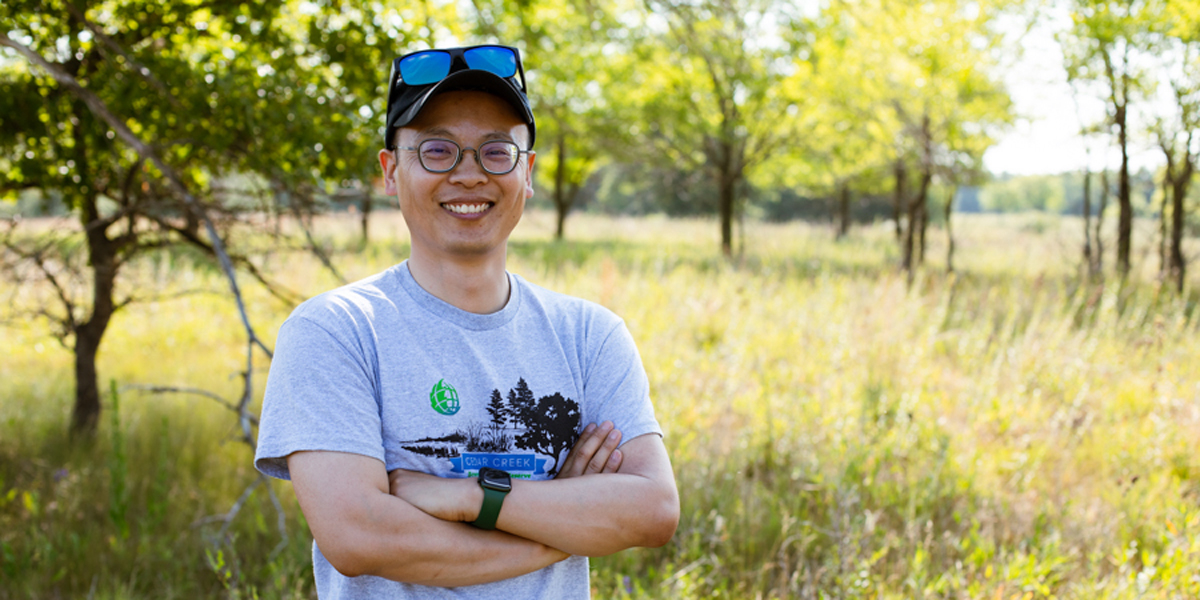
Long before becoming an ecologist, Maowei Liang recalls being deeply impacted by the tangible ways his village in Inner Mongolia experienced global change. Wedged within a mosaic of pasture and agricultural land on the steppes of Inner Mongolia’s windy plateaus, his village was frequently in the path of severe dust storms.
“It was similar, like here, to the Dust Bowl. One day I remember [biking] home from school, and we got hit by this dust storm. When I got home, I washed my face and my hands. The water was super, super dark. I think that's the first time I got a sense of ecology and how environmental changes affect people’s lives.”
But it wasn’t until he witnessed the mountains near his village being blasted and excavated for industry use that he decided to take steps toward a life-long sustainable career.
"They literally cut the mountain. It made this very long scar, and also very deep. Landscape architecture was my preferred career because I believed it had the ability to heal that scar.”
After studying landscape architecture as an undergrad, Maowei took his graduate studies in a slightly different direction and studied ecology. For him, ecology perfectly aligned with his aspirations, as traditional landscape architecture in China always draws inspiration from nature. Eventually, Maowei would take the expertise he gained halfway across the globe to Cedar Creek Ecosystem Science Reserve, where his current role as research scientist allows him to explore the complex interactions of global change and biodiversity loss and how they impact ecosystems over time.
Greener pastures
While obtaining his graduate degree in ecology from Inner Mongolia University, Maowei discovered what every ecologist realizes early in their career: detangling the tightly woven variables of climate, biodiversity, land use and nutrient cycling is a delicate dance.
For his Ph.D. dissertation, he investigated the effects of sheep and cattle grazing on local grassland ecosystems—a complicated but relevant feat given the long history of nomadic herding and environmental issues in Inner Mongolia.
“The [nomadic grazing] land is open for everybody to go there with their livestock. Compared to places never grazed, it’s hard to quantify how much grazing there is because it can be grazed over and over again. The land was long shared harmoniously among humans and wildlife, but such intensive grazing can lead to consequences like dust storms.”
When Maowei successfully conducted a sheep grazing experiment to compare grazed and non-grazed grasslands, he made some complicated discoveries. At first, the grazed plots had more biomass, as well as higher levels of biodiversity, than their non-grazed counterparts; an underlying mechanism in the vegetation actually overcompensated plant growth where livestock grazed the landscape. But he attributes this, in part, to an unusually wet and rainy season the first year at his research site.
“We did not expect that. But then also—the second year was a little more normal, not very wet. We compared those results. We found the wet year was probably more helpful with grazing plots but in the dry year we definitely saw the grazing effects. There was a strong interaction between rainfall variability and grazing intensity.”
Maowei started to ask more and more layered questions related to long term, human-imposed changes on a landscape—i.e. what drives these changes from year to year? 10 years? 20? And because land-use changes like agriculture and livestock have deep, long-lasting impacts on grassland ecosystems all over the world, Maowei unknowingly set himself up for a lifetime of global research.
Take me home, country roads
Cedar Creek seemed to follow Maowei everywhere. After obtaining funding from the Chinese government to research abroad at Michigan State University, Maowei began refining his research skills.
“I remember I wrote the first draft [of my paper there], and in the first paragraph, all the references came from Cedar Creek.”
After his research drew him back to Inner Mongolia to study desert scrubland, and then to the States again to investigate grazing in Arizona’s desert grasslands, Maowei began to see how his combined research interests could make him a perfect fit for a position at Cedar Creek—where bison graze, grasslands thrive, and long-term climate change experiments abound. When a position opened, Maowei took the opportunity to apply.
He spent his first summer gathering data from several of more than 100 sites at Cedar Creek that were once abandoned from agricultural or livestock use. Because there is so much to glean from data at Cedar Creek, Maowei also intends on spending time building models for data that already exists. He also definitely sees a future in which he can dive into the bison experiment at Cedar Creek.
And as far as his village? Maowei feels that the work he’s doing here influences spaces across oceans—Cedar Creek is exactly where he needs to be.
“If we want to help people deeply understand how ecosystems work and how they respond to climate and land-use changes, we need a platform where we can unravel these complexities. It’s like— where can we do more with our influence? It’s not just about going back to where you want to go.” -Adara Taylor